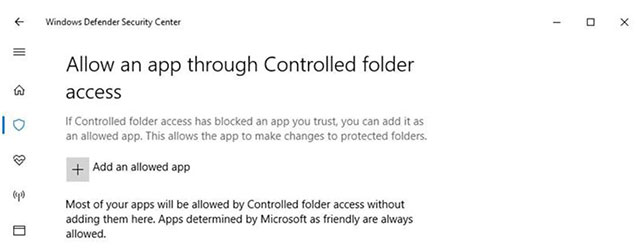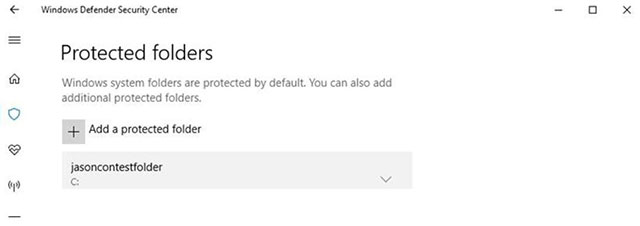Windows 10 brings many security tools in the new update
Two ransomware attacks - WannaCry and Petya (or NotPetya) - have staggered the world in a row, causing many hospitals, ATMs, transport companies and airlines to interrupt operations. Most ransomware are specifically designed to target Windows-based computers. This makes Microsoft more or less criticized for failing to provide timely protection measures and risk prevention for its users.
In that situation, Microsoft finally realized their operating system was vulnerable and the technology giant introduced the anti-ransomware feature in the latest build Windows 10 Insider Preview (16232) with some features. security features.
Microsoft also plans to include these features on Windows 10 Creator Update (or RedStone 3), which will ship between September and October of this year.

Protect your computer with Controlled Folder Access
The anti-ransomware feature, called Controlled Folder Access, is part of Windows Defender, which prevents unauthenticated applications from changing important files placed in protected folders.
Only white list apps can access this protected folder. Users can add or remove applications from the application. Some applications will automatically be whitelisted even if Microsoft does not specify which application.
When the feature is turned on, Controlled Folder Access will track the file stored in the folder and any attempt to access or edit the file by an unlisted application will be blocked by Windows Defender. for ransomware to encrypt important files.
Whenever an application tries to change a protected file, you will receive a notification.
How to enable Controlled Folder Access, whitelist, add and delete protected folders
- Open Start Menu > Windows Defender Security Center.
- Choose Virus & Threat Protection.
- Turn On.
Here's how to let the application you trust access the protected directory.
- Open Start Menu > Windows Defender Security Center.
- Choose Virus & Threat Protection.
- Click Allow an app through Controlled acces folder under Controll Fo ld er Access.
- Click Add an Allowed app and select the application you want to allow.

Allows the application to access protected folders
Windows folders such as Documents, Pictures, Movies and Desktop will be protected by default and cannot be removed.

Add and delete protected folders
However, users can add and delete other personal folders.
- Open Start Menu > Windows Defender Security Center.
- Choose Virus & Threat Protection.
- Click Proteced Folders under Controlled Folder Access.
- Select the directory path.
Other security features on Windows 10 Insider Program
Along with the release of Windows 10 Insider Preview Build 16232, Windows Defender Application Guard (WDAG) for Edge - a new system running Microsoft Edge on a virtual machine specifically to protect OS from browser bugs - also received some improvements.
Windows 10 Insider Preview Build also supports data persistence with Microsoft Edge when using WDAG.
'When enabled, data like cookies, saved passwords, and favorites will be retained through Application Guard sessions,' Microsoft explained. 'Durable data is not shared or located on the host but will be available on Microsoft Edge in the Application Guard session'.
Another security feature called Exploit Protection, introduced on Windows 10 16232, blocks network attacks even without security patches, which means it will be useful for unpublished vulnerabilities. zero-day repair.
Exploit Protection works without Microsoft Windows Defender Antivirus, but you can still find it at Windows Defender Security Center> App & Browser Control> Exploit Protection.
In the Fall update of Fall Creators Update, Microsoft also planned to use a lot of data from Redmond's cloud service, including Azure, Endpoint and Office to create anti-virus via AI (Advanced Thread Protection), can view malware behavior and protect PC.
Microsoft also plans to build EMET or Enhanced Mitigation Experience Toolkit into Windows 10's kernel to increase security from zero-day vulnerabilities. The company will also abandon the Server Message Block version (SMBv1) - a 30-year-old file sharing protocol that is as alcoholic after WannaCry's attack - from Windows 10 Redstone 3 Update (1709).
In addition, there will be some other changes and improvements, along with a few patches for some issues.
You should read it
- How to download Windows 10 Fall Creators Update via Insider Preview
- What will Microsoft 'kill' in Windows 10 Fall Creators Update update?
- Instructions to uninstall Windows 10 Fall Creators Update
- How to recover passwords on Windows 10 Fall Creators Update
- 9 new installation features in Windows 10 Fall Creators Update update
- Instructions for using voice commands on Windows 10 Fall Creators Update
- Windows 10 Fall Creators Update for mobile devices will be released more widely this week
- Prevent Windows 10 Fall Creators Update from reopening applications after restarting
May be interested
- The Windows 10 KB4532693 update fails, causing a user's file to be deleted
 the windows 10 kb4532693 update, released on february 11 by microsoft, includes security fixes and bug fixes. however, this patch brings users even worse problems.
the windows 10 kb4532693 update, released on february 11 by microsoft, includes security fixes and bug fixes. however, this patch brings users even worse problems. - Windows 10 update again, this time not only slowing down the user's computer
 this is an update that brings the new edge browser to windows 10.
this is an update that brings the new edge browser to windows 10. - 10 common errors on Windows 10 and how to fix bugs
 wifi sense feature allows windows 10 users to share wifi networks with friends, without entering a password. it brings convenience but also a security risk. if you don't want to use or worry about security, you can disable the wifi sense feature to prevent any users from automatically connecting to your wifi connection.
wifi sense feature allows windows 10 users to share wifi networks with friends, without entering a password. it brings convenience but also a security risk. if you don't want to use or worry about security, you can disable the wifi sense feature to prevent any users from automatically connecting to your wifi connection. - Instructions for updating on Windows 11
 just like on other versions of windows, regular and periodic feature updates, as well as early application of security patches are extremely important for a system running windows 11.
just like on other versions of windows, regular and periodic feature updates, as well as early application of security patches are extremely important for a system running windows 11. - Attractive features on Windows 10 Creators Update
 the big update for the first time this year of windows 10 brings many useful new features.
the big update for the first time this year of windows 10 brings many useful new features. - This is the last update of Windows 7, what's special?
 windows 7 has officially entered the phase of discontinuing support (eos), meaning that users will not receive any additional feature updates and security patches.
windows 7 has officially entered the phase of discontinuing support (eos), meaning that users will not receive any additional feature updates and security patches. - Learn about terminal security (endpoint security)
 the world of modern information technology brings many benefits but also favorable conditions for bad guys to make use of.
the world of modern information technology brings many benefits but also favorable conditions for bad guys to make use of. - Apple released iOS 11.4.1 update, with features to combat cracking tools
 apple has just released ios 11.4.1, in this update the ios operating system security features continue to be upgraded to limit usb access, against unlocking tools.
apple has just released ios 11.4.1, in this update the ios operating system security features continue to be upgraded to limit usb access, against unlocking tools. - Update Windows software
 how do i keep my computer up to date? there are two tools that can be used together to help your computer always have the latest updates from microsoft: microsoft windows® update and automatic updates. what is windows update? windows update is an interactive web site that allows you to regularly update bug fixes, performance, and features that are compatible with your three windows computers.
how do i keep my computer up to date? there are two tools that can be used together to help your computer always have the latest updates from microsoft: microsoft windows® update and automatic updates. what is windows update? windows update is an interactive web site that allows you to regularly update bug fixes, performance, and features that are compatible with your three windows computers. - Windows 10 KB4056892 emergency update (build 16299.192)
 microsoft released a security update to minimize security vulnerabilities for intel, amd and arm processors, which could put millions of computers at risk. below is an emergency update of windows 10 kb4056892 (build 16299.192).
microsoft released a security update to minimize security vulnerabilities for intel, amd and arm processors, which could put millions of computers at risk. below is an emergency update of windows 10 kb4056892 (build 16299.192).










 WordPress plugins with more than 300,000 pages that use vulnerabilities are vulnerable to SQL Injection attacks
WordPress plugins with more than 300,000 pages that use vulnerabilities are vulnerable to SQL Injection attacks The Linux machine can be remotely hacked with a poisoned DNS response
The Linux machine can be remotely hacked with a poisoned DNS response How to hack Gmail's two-step authentication
How to hack Gmail's two-step authentication Samsung Flow can be used on Windows 10 computers
Samsung Flow can be used on Windows 10 computers Research shows that just getting a smartphone close by can make you 'more foolish'.
Research shows that just getting a smartphone close by can make you 'more foolish'. The researchers successfully cracked 1024-bit RSA in GnuPG Crypto Library
The researchers successfully cracked 1024-bit RSA in GnuPG Crypto Library